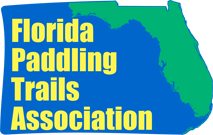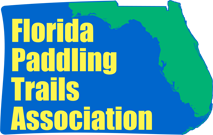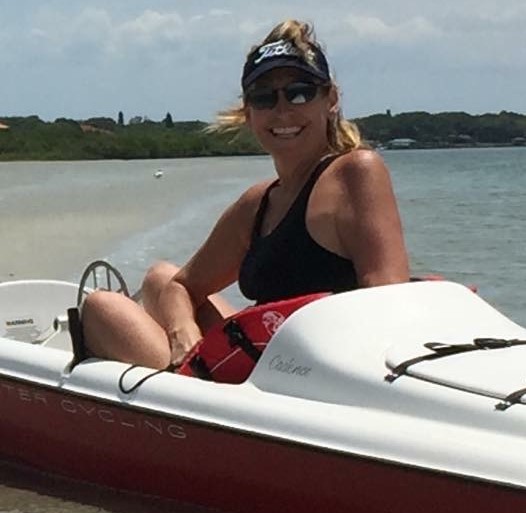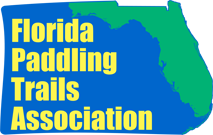About: Florida Paddling Trails Association
-

-
What is the FPTA?
The Florida Paddling Trails Association is a 501(c)(3) non-profit organization formed in 2007 under the guidance of the Department of Environmental Protection's Office of Greenways & Trails to be the steward for all Florida's water trails, including the 1,515-mile Circumnavigational Saltwater Paddling Trail that surrounds the state.
We are a statewide community of paddlers, clubs, outfitters, and other supporters who share a passion for exploring Florida's scenic waterways via canoes, kayaks, and paddleboards.
FPTA's core missions are to:- Develop water trails.
- Protect the environment along the trails.
- Serve as a resource and voice for paddlers.
-

-
Missions of the FPTA
Develop Water Trails- Develop and publicize new and existing water trails, campsites, and launches.
- Establish Blueway Communities by using waterways to develop paddling-based regional ecotourism.
Protect the Environment- Facilitate statewide cleanups of rivers, lakes, springs, and coastal waterways.
- Offer environmental training to paddlers.
- Partner with other groups and organizations committed to stewardship of Florida waters.
Serve as a Resource and Voice for Paddlers- Develop a "one stop shopping" website that has all the kinds of information that paddlers need to plan their activities.
- Build community among statewide paddlers through events, newsletters, social media, and a network of "trail angels."
- Partner with agencies and organizations providing paddler skills training and safety education.
- Develop the next generation of paddlers and waterways stewards through support of youth programs.
- Develop and publicize new and existing water trails, campsites, and launches.
-

-
History of the FPTA & the Florida Circumnavigational Saltwater Paddling Trail
The idea of a paddling trail extending around Florida's peninsula was conceived by environmental lobbyist and paddler David Gluckman in the 1980s after seeing the establishment of the 350-mile Maine Island Trail system. But it wasn't until 2004 that the state of Florida began to seriously consider the possibility of a "circumnavigational" trail, based in part on the successful completion of the Big Bend Saltwater Paddling Trail from the Aucilla River to the town of Suwannee by the Florida Fish and Wildlife Conservation Commission.
In the fall of that year, the Florida Department of Environmental Protection's Office of Greenways and Trails (OGT), at Gluckman's encouragement, hired Doug Alderson to begin scouting the trail. The first segments were in the Amelia Island and Panama City areas. Alderson, an avid outdoorsman and professional writer and photographer, had assisted in writing the guide for the Big Bend Trail.
In 2005, the circumnavigational trail (CT) was officially designated by the Florida Legislature as part of the Florida Greenways and Trails System (Title XVIII, Chapter 260 Florida Statutes). Scouting for the trail was completed in the summer of 2007. Another highlight that summer was the designation of the trail as a national recreation trail by the United States Department of Interior. As the trail neared completion, media outlets were helping to make the trail known to paddlers and the general public. Articles appeared in Undiscovered Florida/National Geographic Traveler, Canadian Geographic, The Palm Beach Post, The Tallahassee Democrat and other publications.
In October of 2007, Alderson organized a statewide gathering in Homosassa Springs to form an independent non-profit association to help maintain and improve the trail. More than 70 people took part in the history-making event. Regional representatives and segment "trail keepers" from throughout the state were chosen. A subsequent board meeting in Cedar Key adopted by-laws, set up committees to help operate the non-profit group, and agreed on an official name—the Florida Paddling Trails Association.
For its first president, the new board elected Safety Harbor resident Hank Brooks, a retired business consultant and former president of the Tampa Bay Sea Kayakers. Board members attending that first meeting included Ray Hetchka of Fernandina Beach, Fred Borg of Panama City, Gerry Gaudet of Deerfield Beach, Krueger Nicholson of Long Key, Gary Breedlove of Tallahassee, Doug Alderson of Tallahassee, and Marv Phelps of Brooksville. The following month, in December of 2007, the FPTA was officially incorporated by the state of Florida, and the first e-newsletter was sent to almost a thousand interested persons around the state.
In February of 2008, two milestones were reached: the FPTA launched its website with help from Brooks, Alderson, Ed Schessl, John Norris and Bill Reynolds; and the first membership brochures were printed. The group began raising the initial funds necessary to operate the association.
Throughout 2008, the new volunteer operations manager, John Norris, and others began giving talks to paddling clubs around the state. It was soon realized that the majority of Florida paddlers enjoy paddling rivers and streams. It was decided to expand the FPTA scope to also cover river trails and to solicit trail keepers for rivers and to partner with existing paddling clubs. The FPTA began its evolution as an umbrella organization that embraced all paddling trails in Florida.
In 2009, new interior regions and segments were added for a total of 15 regions and 32 segments statewide.
With a grant from the Elizabeth Ordway Dunn Foundation, Hank Brooks spearheaded the Paddlers Environmental Toolkit Training program in 2009. Through this training, more than 350 paddlers were taught to recognize and report environmental problems and learn basic plant and animal identification.
In 2010, work continued to add more paddling trails and trip reports to the website, to develop a comprehensive online calendar, and to fill board positions. A new mission was also added: "A resource and voice for Florida paddlers." Dan Thompson and others began to raise more revenues through grants, memberships, and business sponsors to help the all-volunteer organization carry out its mission. Incoming president Tom McLaulin spearheaded the FPTA blueways communities project. By 2016, a total of 40 communities and 15 counties participated and earned recognition as paddling-friendly destinations.
The first statewide gathering of CT paddlers was held at Silver Springs State Park May 16-18, 2014, organized by OGT's Liz Sparks. FPTA was a main sponsor. It was believed that enough people had completed the entire trail to help build momentum by starting annual gatherings at different locations. "Trail angels", people who help paddlers on the trail, were honored. Six thru-paddlers were in attendance--Carl Anderson, Ian Brown, Jim Windle, Marc DeLuca, Gus Bianchi and Daniel Alvarez--along with people who had paddled significant sections of the trail and other interested parties. The Ocala Star Banner published a feature article about the gathering. Besides hosting the CT gathering, the FPTA supported the Florida Paddlers Rendezvous, the Hidden Coast Paddling Festival and the Loxahatchee River Race.
In the fall of 2015, the FPTA board elected new leaders. Jill Lingard became president, Monica Woll was the new Secretary, Deb Akin agreed to serve as treasurer and Dan Thompson agreed to continue as vice president until spring when the position would be filled by Esther Luft. "Where water is concerned, I enjoy the intersection of recreation, discovery and stewardship," said incoming president Jill Lingard. "I have come to learn that FPTA fills that bill beautifully."
FPTA initiated the Legacy Fund in 2016. Volunteer donations coupled with a grant from Paddle Nation enabled 42 boys and girls to attend paddling camps around the state that summer. Since then, Legacy Fund donations have sent nearly 150 children to summer paddling camps, helping to develop Florida's next generation of paddlers and waterway stewards.The organization continues to provide annual support to the Florida Paddlers Rendezvous, the Hidden Coast Paddling Festival, and many other regional paddling events throughout the state, in addition to hosting the CT Reunion each April. Twenty-four CT thru-paddlers have completed the 1,515-mile journey and a growing number of trail angels across the state remains committed to assisting them along the way. FPTA also oversees a robust Facebook group which offers paddlers a forum to share their travels, photos, gear tips, and any news that impacts our sport or the environments we so enjoy exploring.Year President Volunteer of Year 2007 Hank Brooks 2008 Hank Brooks John Norris 2009 Hank Brooks Judy Engel 2010 Hank Brooks Esther Luft 2011 Tom McLaulin Dan Thompson 2012 Tom McLaulin Deb Akin 2013 Tom McLaulin Tom McLaulin 2014 Tom McLaulin 2015 Jill Lingard Gus Bianchi 2016 Jill Lingard Bill Stasiewicz 2017 Jill Lingard John Corzine 2018 Jill Lingard Steve Cournoyer -

-
FPTA Directors & Managers

Jill LingardPresident

Esther Alonso-LuftVice President

Debra AkinTreasurer

Joe WebbRegion A Co-Director

Tom McLaulinBlueway Coordinator

Doug AldersonGreenways & Trails

Diane Rickman-BuckalewRegion A Co-Director

Tommy ThompsonRegion B Director

Russ McCallisterRegion C Director / Secretary

Hank BrooksRegion D Director

Edward EngelRegion E Director

Mike HammondRegion F Director

Monica WollRegion G Director / Newsletter

Ted PerronRegion H Director

Ted PerronRegion I Director

John CorzineRegion J Director

Angelia DouglasRegion K Director

John PretzelRegion L Director

Bill StasiewiczRegion M Director

Larry WuestRegion N Director

John ShinnerRegion O Director
-

-
Bylaws of the FPTA
(Bylaws revised on Feb 25, 2012)Article I - Name
The name of the organization shall be the Florida Paddling Trails Association. It shall be a nonprofit organization incorporated under the laws of the State of Florida For the remainder of these by-laws it will be referred to as the Association.Article II - Purpose/ Mission
The mission of the Florida Paddling Trails Association is to develop water trails, protect the environment, and be a resource and voice for paddlers. The Association will be the steward of all Florida's water trails, in cooperation with the Florida Department of Environmental Protection's Office of Greenways and Trails and other local, regional, state and federal entities.Article III — Membership
3.1 Membership. Membership shall be open to all persons, regardless of race, color, religion, age, national origin, sex or sexual orientation, who express their interest in the Association and who pledge to uphold the ethics of the Association.
3.2 Dues. The amount of dues shall be set annually by the Association Board of Directors and may be established at varying levels depending on the type of membership. Only those members whose dues are currently paid shall be entitled to the benefits of membership.
3.3 Votes. Each member of good standing shall have one vote. If a partnership or corporation shall be a member, the entity will have only one vote. A simple majority will decide issues unless specified otherwise.
3.4 Default of Dues. Any member whose dues remain unpaid for a period of one month after they have become due may be dropped from the membership roles.Article IV - FPTA Organization
4.1 Regions. For control purposes, the Association has divided the state into 15 regions which are lettered A through O. Each region will have from 2 to 3 segments. Each region will have a Regional Director who will serve on the Association Board of Directors. A region may adopt a name for their specific region and submit it to the board for approval.
4.2 Trail Segments. Each region is divided into two or three segments. Each segment will have one or more volunteer "Trail Keepers" to monitor water trails within their segment.Article V - Meetings
The various types of meetings within the Association are:
5.1 Board of Directors Meeting. These will be held a minimum of once a year for all Association Officers and Board Members and will be chaired by the Association President.
5.2. Special Meetings. The Association President may call a special meeting for the Board at any time with 30 days notice. A Regional Director may call a meeting of his/ her region at any time. In an emergency, the President may call for a phone conference or internet meeting.
5.3 Voting. Each board member shall be entitled to one vote. All questions shall be decided by a majority vote cast in person at a meeting at which there is a quorum present unless otherwise provided in these bylaws. Prior to voting on important matters, an attempt will be made to reach a consensus. For special meetings held electronically or by phone, votes can be made either electronically or by phone.
5.4 Quorum. At the Board of Directors' meetings, a quorum shall consist of a majority of the Board of Directors actively serving in their positions. There will be no quorum requirements for regional meetings.Article VI - Association Board of Directors & Officers
6.1 The Association Board of Directors
The Board of Directors will consist of:- President
- Vice President
- Secretary
- Treasurer
- Office of Greenways & Trails Representative. The Florida Department of Environmental Protection's Office of Greenways and Trails shall appoint one board member who shall serve as a liaison between the Department and the association.
- One board representative from each FPTA district. The fifteen FPTA regions in the state of Florida will be aligned as follows:
- District 1 – Regions A, B & C
- District 2 – Regions D, E & F
- District 3 – Regions G, H & I
- District 4 – Regions J, K & L
- District 5 – Regions M, N & O
- The Regional Directors within each district will elect one Regional Director to be their representative on the board of directors and to represent their district at board meetings.
- If the district board representative cannot attend a board meeting, he/ she may ask another district Regional Director to attend the meeting in his/ her place. If this is not possible, the board representative may ask a FPTA member in good standing to represent the district at the board meeting. These temporary replacements will have full voting rights at the board meeting.
- All Regional Directors are invited to board meetings. However, only one Regional Director per district will have a vote at the board meeting.
- Neither proxy voting (assigning your vote to another voting board member) nor phone voting is allowed.
The Association will have the following officers:- President
- Vice President
- Secretary
- Treasurer
- Qualifications: Must be a member in good standing in the Florida Paddling Trails Association.
- Nomination: Any board member, or FPTA member in good standing, can make officer nominations by sending a written nomination to the Association Secretary prior to the last board meeting of the year.
- Election: Association officers will be elected at the last board meeting of the year by a majority vote of the board members.
- Length of Term: One year with no limit on the number of terms.
- Regional Director: The President should appoint a Regional Director for each of the fifteen regions when there is a qualified candidate willing to accept the appointment. Said appointment to be approved by the Executive Committee, and reviewed by the Board of Directors at the next scheduled board meeting.
- Length of Term: One year. Directors will automatically be reinstated at the beginning of each year, unless they notify the President they no longer wish to serve.
- Terms: Terms will normally be for one year with no limit on the number of terms.
- Suspension or Removal: An officer, board member or Regional Director may be suspended or removed with or without cause by the affirmative vote of two thirds of the Board of Directors.
- Resignation: An officer may resign by delivering her or his written resignation to the Board of Directors. Such resignation shall be effective upon receipt unless specified to be effective at some other time.
- Vacancies: Vacancies in the offices occurring during the corporate year shall be filled by the President until the next scheduled election.
- Meeting Absence
- If the President cannot attend a board meeting, the Vice President will conduct the meeting.
- If a board district representative cannot attend a meeting, he / she may appoint another Regional Director or other member in good standing in their district to attend the meeting and act in their place.
- Conflict of Interest and Meeting Policy: When a vote is to be taken by the Board, a board member may be challenged by another on a claim of conflict of interest. This challenge will take precedent over the matter at hand and be opened for discussion and vote. A majority vote shall be binding. If conflict of interest is determined, the board member so challenged shall refrain from further discussion on the matter at hand and shall not vote on the single matter on which she or he was challenged. The overriding policy of the Board shall be to conduct its affairs in an open manner to the maximum extent possible, consistent with the need for limited executive sessions for discussion of sensitive matters such as, but not limited to, personnel, pending litigation, or negotiating positions.
- Expenses Incurred: Board members shall not receive any salary or fees for their services. Board of Directors may be reimbursed for approved expenses incurred in connection with service performed for the corporation in their activity as Board Members or otherwise. Written records are required for expenses.
- Exculpation: No member, Board Member, officer, Regional Director or volunteer of the Association shall be liable for acts or defaults of any other member, Board Member, officer, for any loss sustained by the Association or any member thereof, or liability of the Association, unless the same has resulted from his or her own willful misconduct or gross negligence.
- Duties of Officers: The duties of the officers shall be as follows:
- Board of Directors. Management of the business, property and affairs of the Corporation shall be controlled by the Board of Directors. In addition to powers granted by the Articles of Incorporation and these Bylaws, the Board of Directors may exercise all such powers and perform all such lawful acts as are not prohibited by the Articles of Incorporation or by these Bylaws.
- Association President. The President shall serve as the President of the Association, shall preside at meetings of the members and the Board, shall appoint a Board representativesfor each committee; shall insure that the committees function effectively; and shall perform such other duties as are incidental to the office.
- Association Vice President. The Vice President shall serve in the place of the President if for some reason the President cannot perform his/ her duties. It is the intention that we have a succession plan for the President. The goal is to elect a Vice President who will replace the President when the President is ready to step down.
- Secretary. The Secretary shall keep minutes of all the meetings of the Board of Directors and shall have other duties as may from time to time be assigned by the Board of Directors.
- Treasurer. The Treasurer shall be responsible for overseeing the financial functions of the Corporation, shall keep or direct the maintenance of the corporation book and other financial records of the Corporation, shall file the appropriate tax forms each year, and shall submit the proposed annual budget for the Board's consideration.
- Operating Procedures. Specific procedures will be written as necessary to explain the operation of the Association, officers and staff.
Article VII - Executive Committee
Executive Committee: The five officers which will serve as the members of the Executive Committee are the President, Vice President, Secretary, Treasurer, and Director from the Office of Greenways and Trails. Except for the power to amend the Articles of Incorporation and bylaws, the Executive Committee shall have all the powers and authority of the Board of Directors in the intervals between meetings of the board of directors, with a limit of spending no more than $1000 without full board approval. A summary of the Executive Committee's actions must be made to the Board at the next Board Meeting. Executive Committee meetings and votes may be held by phone or electronically.Article VIII - Association Volunteers
8.1 Segment Trail Keepers- Qualification: Should be a member in good standing in the Florida Paddling Trails Association.
- Nomination: Nominations sent to the Regional Director.
- Appointment: This is a volunteer position appointed by the Regional Director. no election necessary.
- Length of Term: One year. Can be re-appointed as often as needed.
The trail volunteers will work under the direction of the appropriate Segment Trail Keepers. Names & contact information of volunteers will be forwarded to the appropriate Segment Trail Keeper.Article IX - Board Committees
The President shall appoint appropriate committees to handle Association business as required. One of the committees will be:
9.1 Finance Committee: The Treasurer is the chair of the Finance Committee, which includes three other board members. The Finance Committee is responsible for developing and reviewing fiscal procedures, fundraising plans, and the annual budget with staff and other board members. The board must approve the budget and all expenditures must be within budget. Any major change in the budget must be approved by the board or the Executive Committee. Annual reports are required to be submitted to the board showing income, expenditures, and pending income. The financial records of the organization are public information and shall be made available to the membership, board members, and the publicArticle X - Authority to Dispose of Funds or Property
Authority to make disposition of funds or property shall be the responsibility of the Board of Directors. Such authority may be delegated in writing to such officers, or committees as the Board deems necessary. If the Board of Directors decides to dissolve the Association, all assets of the Association, after payment of all debts, will be donated to a non-profit organization selected by the Board of Directors.Article XI - Fiscal Year
The fiscal year of the Association shall be from January 1 to December 31 of each calendar year.Article XII - Audit and Annual Report
The accounts of the Association shall be reviewed by an audit committee appointed by the President each year at the end of the fiscal year and an Annual Report prepared and presented to the Board of Directors and members.Article XIII - Conduct of Meetings
The conduct of a meeting shall be governed by Robert's Rules of Order as revised unless other procedures or rules are accepted by a majority present and voting at the meeting.Article XIV - Amendments
These bylaws may be amended when necessary by two-thirds majority of the Board of Directors. Proposed amendments must be submitted to the Secretary to be sent out with regular board announcements. -

-
Trail Keeper Responsibilities & Guidelines
